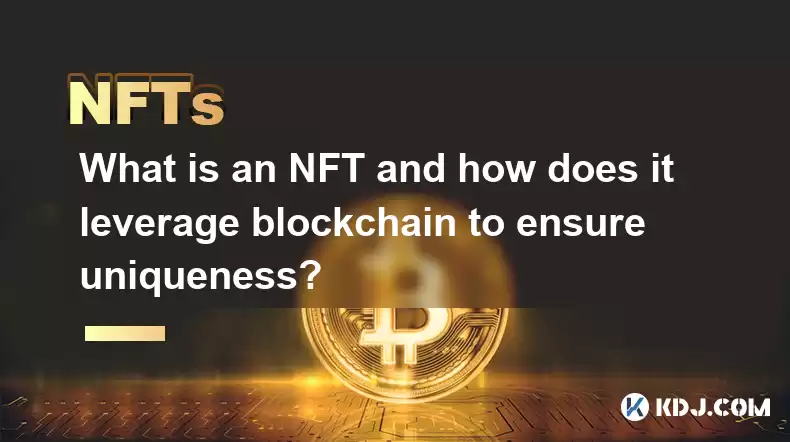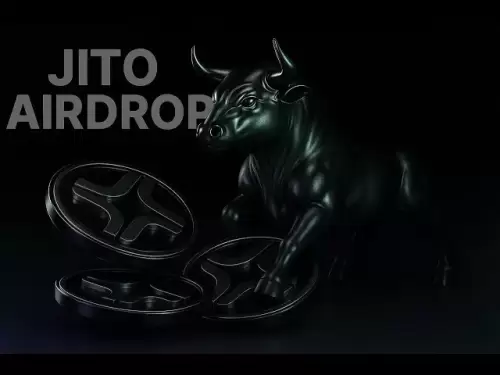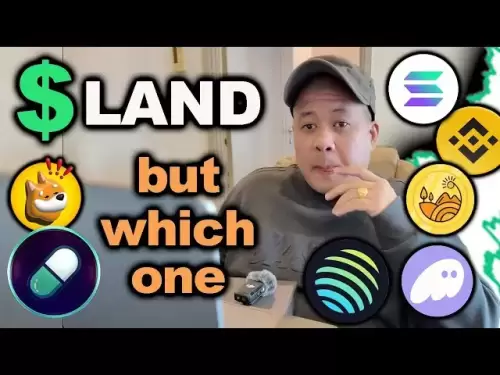-
 Bitcoin
Bitcoin $118600
0.36% -
 Ethereum
Ethereum $3855
1.06% -
 XRP
XRP $3.195
-0.09% -
 Tether USDt
Tether USDt $1.000
-0.04% -
 BNB
BNB $844.5
6.23% -
 Solana
Solana $191.3
2.83% -
 USDC
USDC $0.9997
-0.01% -
 Dogecoin
Dogecoin $0.2376
0.10% -
 TRON
TRON $0.3242
0.83% -
 Cardano
Cardano $0.8222
0.13% -
 Hyperliquid
Hyperliquid $45.26
6.53% -
 Sui
Sui $4.200
-2.56% -
 Stellar
Stellar $0.4336
-1.24% -
 Chainlink
Chainlink $18.86
0.28% -
 Hedera
Hedera $0.2796
-1.75% -
 Bitcoin Cash
Bitcoin Cash $583.3
-1.84% -
 Avalanche
Avalanche $27.06
8.09% -
 Litecoin
Litecoin $112.3
-1.16% -
 Toncoin
Toncoin $3.353
0.58% -
 UNUS SED LEO
UNUS SED LEO $8.968
-0.11% -
 Shiba Inu
Shiba Inu $0.00001395
-0.54% -
 Ethena USDe
Ethena USDe $1.001
-0.03% -
 Uniswap
Uniswap $10.76
0.69% -
 Polkadot
Polkadot $4.175
0.26% -
 Monero
Monero $326.7
1.07% -
 Bitget Token
Bitget Token $4.665
1.61% -
 Dai
Dai $0.9998
-0.02% -
 Pepe
Pepe $0.00001271
0.32% -
 Cronos
Cronos $0.1416
2.01% -
 Aave
Aave $299.3
1.15%
What is an NFT and how does it leverage blockchain to ensure uniqueness?
NFTs use blockchain technology to ensure uniqueness and authenticity, with each token having a unique identifier stored on the blockchain, making duplication impossible.
Apr 27, 2025 at 09:49 pm

An NFT, or Non-Fungible Token, is a unique digital asset that represents ownership or proof of authenticity of a specific item or piece of content, typically stored on a blockchain. Unlike cryptocurrencies such as Bitcoin or Ethereum, which are fungible and can be exchanged on a one-to-one basis, NFTs are distinct and cannot be exchanged on a like-for-like basis. This uniqueness is what makes NFTs valuable in the digital world, as they can represent anything from art, music, and videos to virtual real estate and collectibles.
NFTs leverage blockchain technology to ensure their uniqueness and authenticity. Blockchain is a decentralized and distributed digital ledger used to record transactions across numerous computers, ensuring that the data is secure and unalterable. Each NFT contains a unique identifier, which is stored on the blockchain, making it impossible to duplicate or counterfeit. This technology provides a transparent and verifiable way to track the ownership and provenance of an NFT, ensuring that it remains unique and authentic.
How NFTs Use Blockchain to Ensure Uniqueness
The core of an NFT's uniqueness lies in its use of blockchain technology. When an NFT is created, or "minted," it is assigned a unique identifier, often in the form of a cryptographic hash. This identifier is then recorded on the blockchain, creating an immutable record of the NFT's existence and ownership. The blockchain's decentralized nature ensures that no single entity can alter this record, thereby maintaining the NFT's uniqueness.
Smart contracts play a crucial role in the functionality of NFTs. These are self-executing contracts with the terms of the agreement directly written into code. When an NFT is minted, a smart contract is used to define the rules and conditions of the NFT, such as ownership rights and transferability. The smart contract ensures that the NFT can only be transferred according to the predefined rules, further ensuring its uniqueness and authenticity.
The blockchain's transparency is another key factor in ensuring the uniqueness of NFTs. Every transaction involving an NFT is recorded on the blockchain, creating a public and verifiable history of the NFT's ownership and transfers. This transparency allows anyone to trace the NFT's provenance, ensuring that it is indeed unique and not a duplicate.
The Process of Minting an NFT
Minting an NFT involves creating a new token on the blockchain and assigning it to a specific digital asset. Here is a detailed look at the process:
Choose a Blockchain Platform: The first step is to select a blockchain platform that supports NFTs, such as Ethereum, Binance Smart Chain, or Flow. Each platform has its own set of tools and standards for creating NFTs.
Create or Select the Digital Asset: The next step is to create or select the digital asset that the NFT will represent. This could be a piece of art, a music file, a video, or any other digital content.
Set Up a Digital Wallet: To interact with the blockchain, you need a digital wallet that supports the chosen blockchain platform. Popular wallets include MetaMask for Ethereum and Trust Wallet for Binance Smart Chain.
Connect to an NFT Marketplace: Many NFT marketplaces, such as OpenSea, Rarible, and Mintable, provide user-friendly interfaces for minting NFTs. Connect your digital wallet to the marketplace of your choice.
Upload the Digital Asset: Upload the digital asset to the NFT marketplace. You will need to provide details such as the name, description, and any other relevant information about the asset.
Set the NFT's Properties: Define the properties of the NFT, such as its price, royalties, and any other conditions. These properties are encoded into the smart contract that will govern the NFT.
Mint the NFT: Once all the details are set, you can mint the NFT. This process involves executing the smart contract on the blockchain, which creates the NFT and assigns it to your digital wallet. You will need to pay a gas fee, which covers the cost of processing the transaction on the blockchain.
List the NFT for Sale: After minting, you can list the NFT for sale on the marketplace. Buyers can then purchase the NFT, and the ownership will be transferred to their digital wallet.
The Role of Metadata in NFTs
Metadata is crucial in defining the uniqueness of an NFT. When an NFT is minted, it is associated with a set of metadata that describes the digital asset it represents. This metadata can include details such as the asset's name, description, creator, and any other relevant information. The metadata is stored on the blockchain alongside the NFT, ensuring that it remains linked to the token and cannot be altered.
The immutability of metadata on the blockchain is what ensures the NFT's uniqueness. Once the metadata is recorded, it cannot be changed, ensuring that the NFT remains tied to the specific digital asset it represents. This immutability is what gives NFTs their value, as it guarantees that the token is unique and cannot be replicated.
The Importance of Token Standards
Token standards are essential for ensuring the interoperability and uniqueness of NFTs across different platforms. The most widely used standard for NFTs on the Ethereum blockchain is ERC-721, which defines a set of rules for creating and managing non-fungible tokens. Other standards, such as ERC-1155, allow for the creation of both fungible and non-fungible tokens within the same contract, providing more flexibility.
Adhering to token standards ensures that NFTs can be recognized and traded across different marketplaces and platforms. This interoperability is crucial for the widespread adoption of NFTs, as it allows creators and collectors to engage with a broader ecosystem. The standards also help maintain the uniqueness of NFTs by ensuring that they are created and managed according to a set of predefined rules.
The Impact of NFTs on Digital Ownership
NFTs have revolutionized the concept of digital ownership by providing a secure and verifiable way to own and trade digital assets. Before the advent of NFTs, digital content was easily replicable, making it difficult to establish ownership. With NFTs, creators can now monetize their digital work by selling unique tokens that represent ownership of their content.
The blockchain's role in ensuring the uniqueness of NFTs is what makes this possible. By providing a tamper-proof record of ownership and provenance, the blockchain ensures that each NFT is unique and cannot be duplicated. This has opened up new opportunities for artists, musicians, and other creators to monetize their work in the digital space.
Frequently Asked Questions
Q: Can NFTs be fractionalized?
A: Yes, NFTs can be fractionalized, allowing multiple people to own a portion of a single NFT. This is typically done through the creation of fungible tokens that represent shares in the NFT. Fractional ownership can make high-value NFTs more accessible to a broader audience.
Q: How do royalties work with NFTs?
A: Royalties are a feature of many NFTs, allowing creators to earn a percentage of the sale price every time their NFT is resold. This is implemented through smart contracts, which automatically transfer the royalty payment to the creator's wallet upon resale.
Q: Are NFTs environmentally friendly?
A: The environmental impact of NFTs is a topic of debate, primarily due to the energy consumption associated with blockchain networks like Ethereum. However, efforts are being made to transition to more energy-efficient blockchain solutions, such as Ethereum's move to proof-of-stake.
Q: Can NFTs be used for physical assets?
A: Yes, NFTs can be used to represent ownership of physical assets. This is often done by linking the NFT to a physical item through a process known as tokenization. The NFT serves as a digital certificate of ownership, while the physical asset remains in the real world.
Disclaimer:info@kdj.com
The information provided is not trading advice. kdj.com does not assume any responsibility for any investments made based on the information provided in this article. Cryptocurrencies are highly volatile and it is highly recommended that you invest with caution after thorough research!
If you believe that the content used on this website infringes your copyright, please contact us immediately (info@kdj.com) and we will delete it promptly.
- Avalanche (AVAX) Price Pump Incoming? Analysts Weigh In
- 2025-07-29 06:50:12
- Presales, Investment, July 2025: What's Hot and What's Not
- 2025-07-29 06:30:12
- PayPal, Bitcoin, and Merchants: A New Era of Commerce?
- 2025-07-29 07:10:13
- RUVI Token's Ripple Rally Potential: Audited AI Crypto Heats Up!
- 2025-07-29 04:50:12
- ADA Price, Cardano, SUI & Remittix: Decoding the Latest Crypto Moves
- 2025-07-29 04:50:12
- Solana, ARK Invest, and Staking: A New Era of Institutional Crypto?
- 2025-07-29 05:30:12
Related knowledge

Is it possible to get a refund on an NFT?
Jul 21,2025 at 08:35pm
Understanding NFT Transactions and RefundsWhen you purchase an NFT (Non-Fungible Token), the transaction is typically recorded on a blockchain, making...

What happens to NFTs when the owner dies?
Jul 22,2025 at 02:43pm
Legal Ownership and Digital AssetsWhen an individual owns NFTs, the question of what happens to these assets upon their death is a pressing one. NFTs ...

What are the tax implications of gifting an NFT?
Jul 19,2025 at 04:21am
Understanding the Basics of NFT GiftingGifting a Non-Fungible Token (NFT) involves transferring ownership from one individual to another without recei...

Can you trade NFTs on your phone?
Jul 18,2025 at 04:29am
Trading NFTs on Mobile DevicesYes, you can trade NFTs on your phone, and the process has become increasingly streamlined thanks to a variety of mobile...

How to find out about upcoming NFT mints?
Jul 18,2025 at 11:50am
Exploring NFT Minting OpportunitiesUnderstanding the landscape of upcoming NFT mints is crucial for collectors, investors, and creators who wish to st...

What is an allowlist or whitelist for an NFT mint?
Jul 20,2025 at 07:14pm
Understanding the Concept of an Allowlist for NFT MintingAn allowlist, also commonly referred to as a whitelist, is a mechanism used in the NFT mintin...

Is it possible to get a refund on an NFT?
Jul 21,2025 at 08:35pm
Understanding NFT Transactions and RefundsWhen you purchase an NFT (Non-Fungible Token), the transaction is typically recorded on a blockchain, making...

What happens to NFTs when the owner dies?
Jul 22,2025 at 02:43pm
Legal Ownership and Digital AssetsWhen an individual owns NFTs, the question of what happens to these assets upon their death is a pressing one. NFTs ...

What are the tax implications of gifting an NFT?
Jul 19,2025 at 04:21am
Understanding the Basics of NFT GiftingGifting a Non-Fungible Token (NFT) involves transferring ownership from one individual to another without recei...

Can you trade NFTs on your phone?
Jul 18,2025 at 04:29am
Trading NFTs on Mobile DevicesYes, you can trade NFTs on your phone, and the process has become increasingly streamlined thanks to a variety of mobile...

How to find out about upcoming NFT mints?
Jul 18,2025 at 11:50am
Exploring NFT Minting OpportunitiesUnderstanding the landscape of upcoming NFT mints is crucial for collectors, investors, and creators who wish to st...

What is an allowlist or whitelist for an NFT mint?
Jul 20,2025 at 07:14pm
Understanding the Concept of an Allowlist for NFT MintingAn allowlist, also commonly referred to as a whitelist, is a mechanism used in the NFT mintin...
See all articles

























































































